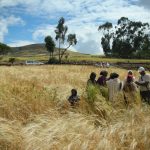Coinciding with the Pre-Summit of the UN Food Systems Summit taking place in Rome 26–28 July 2021 CAPITALISE experts from SSSA introduce the importance of agrobiodiversity to food systems.
Biodiversity is the diversity of life on earth, including plants, animals, fungi, and microorganisms. Our food system relies on a very special part of biodiversity called agrobiodiversity. This is not only the diversity of all organisms associated with agriculture, but also the result of human ingenuity in manipulating biodiversity through breeding and landscaping.
At the genetic level, agrobiodiversity includes the diversity found between varieties and landraces of the same crop, but also extends to diversity present in ‘crop wild relatives’, these are wild plants that are distant relatives of cultivated plants. Evolving crops through breeding and genomic techniques to include desirable traits relies on the maintenance and exploitation of genetic resources. Work led by SSSA in the EC funded CAPITALISE project is part of global efforts by scientists exploring agrobiodiversity to develop genetic tools critical for improving crop performance to support both resilience to climate stresses, and local adaptation to low-input agriculture.
Despite the importance of this richness of genetic resources is at risk of being progressively and irreversibly lost due to changes in land use and standardization of modern agriculture. Even if a portion can be maintained in situ across different agroecosystems worldwide, growing concerns around the risks have triggered a rush to collect and secure as much agrobiodiversity as possible. This action has led to a significant portion of these resources being maintained ex situ in seed collections, available to breeders and researchers to fuel crop improvement.




In situ or ex situ genetic agrobiodiversity may provide breakthroughs to make the crops of the future more sustainable and more productive, capable of growing better today and including adaptions to combat effects of climate change tomorrow. Modern DNA sequencing allows us to read the information in the genome of seed collections and harness and use the genetic information for modern crop improvement. Thanks to DNA sequencing, we know how to efficiently read the information contained in these collections. Genomics is the science aimed at extracting information from DNA sequences and allows us to understand the structure, function, and evolution of crop genomes.
Sequencing the DNA of landraces, wild relatives and varieties belonging to the same crop, is helping us understand the extent of variation available for breeding. Combining this information with the characterization of the agronomic performance of these collections, we can understand which biological processes underlie traits of interest, and identify which plants carry favourable diversity. Traits that can be selected and improved from the characterization of in situ and ex situ agrobiodiversity include higher yield, pest resistance, energetic efficiency, resistance to extreme climatic events.
Climate change and the demands of growing populations are creating new environmental pressure on agriculture. Maintaining agrobiodiversity and characterizing underlying mechanisms in projects such as CAPITALISE is groundwork that can help us to build a more sustainable food system for tomorrow’s agriculture, improving our chances to cope with the effects of climate change and address food security needs.
This complements the parallel session “Agrobiodiversity for a Sustainable Future” by the Alliance of Bioversity International and the International Center for Tropical Agriculture.




